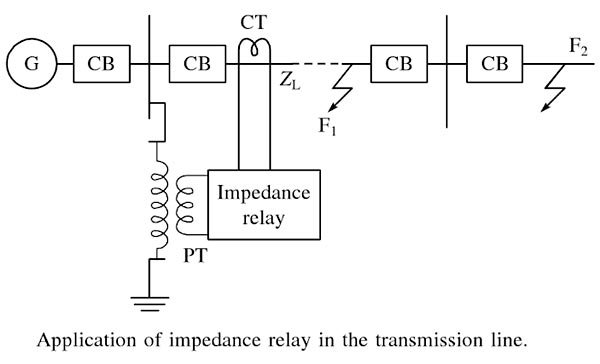If the fault occurs near the impedance relay, the VI ratio will be
Right Answer is:
Lower than that of if the fault occurs away from the relay
SOLUTION
Distance Relaying
Overcurrent relays, differential relays, or directional relays operate if the amount of current or power exceeds a preset value. But the distance relays are governed by the ratio of the applied voltage to the current. These relays include impedance relays, reactance relays, and mho relays.
The distance relaying scheme entails the use of a dual input comparator, and it works on the basis of a working torque, which is produced by the current coil and voltage coils. For example, an impedance relay operates when the ratio V/I is less than a predetermined value. The current coil of the relay receives the line current while the voltage coil of the relay is supplied with the bus voltage. The reach of the distance relay cannot be shifted by the switching operation or a change in the generation capacity or the type of fault. Phase distance relays, which are used for the phase fault involving two or more phases, are fed with delta voltage and delta current (line voltage and line current). For the line to ground fault, the relay is supplied with star voltage and star current, i.e. the phase voltage and phase current.
Application of Impedance Relay
The figure shows a simple application of the impedance relay in the transmission line. The protected zone impedance is ZL if the fault occurs say at point F1 inside the protected zone. The relay compares the impedance of the part of the line between fault point F1 and the place where the relay is installed (ZF = V/I). The relay will operate because of ZF < ZL . But the relay will not operate if the fault occurs outside the protected zone because in that situation ZF > ZL.

Distance relaying works both as the primary as well as the backup protection. Distance relays are of two types: the definite distance relay operates instantaneously for a fault occurring up to a predetermined distance from the relay and the time distance relay is used when the operation of time is proportional to the distance of the fault point from the relay. The time distance relay operates faster in case of a fault occurring closer to the relay than that occurring farther away from the relay fault closer to the relay operates earlier than the fault farther away from the relay. If the relay closer to the fault point fails, the next relay works as backup protection.
